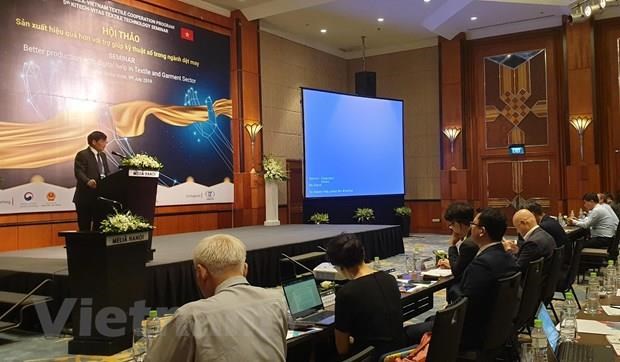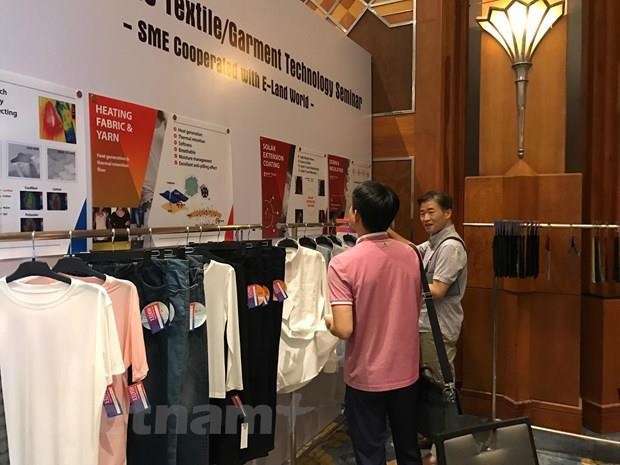Garment sector needs modern technology to keep up with global trends
Vietnam's textile and garment sector needs advanced technology to keep pace with global trends and to expand export markets, Trade Counsellor of the Republic of Korea in Vietnam Kim Eu Joong has said.
 Delegates to the seminar themed “Better production with digital help in garment and textile sector” (Photo: VietnamPlus)
Delegates to the seminar themed “Better production with digital help in garment and textile sector” (Photo: VietnamPlus)Hanoi (VNA) – The Vietnamese textile and garment sector needs advanced technology to keep pace with global trends and to expand export markets, Trade Counsellor of the Republic of Korea (RoK) in Vietnam Kim Eu Joong has said.
Kim made the statement at a seminar in Hanoi on July 9 on digital technology in the garment and textile sector. Held by the Vietnam Textile and Apparel Association (VITAS) and the Korea Institute of Industrial Technology (KITECH), the seminar aimed to introduce advanced technology in the sector and share knowledge between Vietnam and the RoK as well as Asian countries, thus fostering their cooperation in the industry.
The trade counsellor advised the Vietnamese Government to invest in high technology for production, saying that his country, with its system of technical research institutes, can provide technical assistance for Vietnam.
He added that the European Union–Vietnam Free Trade Agreement (EVFTA), once coming into effect, will open up opportunities for the Vietnamese garment and textile sector, especially in increasing export turnover.
Truong Van Cam, VITAS Vice President, said trade cooperation between Vietnam and the Republic of Korea has developed rapidly over the past years.
In 2018, Vietnam enjoyed a trade surplus of more than 29 billion USD with the East Asian country. In the garment and textile sector, the latter is Vietnam’s largest investor with 4.7 billion USD, accounting for a quarter of the total investment.
He hailed the results of the annual training programme run by the Vietnam Textile and Apparel Association and the Korea Institute of Industrial Technology to increase competitiveness for garment and textile enterprises and share experience in digital transition.
 Vietnam enjoys trade surplus of more than 29 billion USD with the Republic of Korea in 2018 (Photo: VietnamPlus)
Vietnam enjoys trade surplus of more than 29 billion USD with the Republic of Korea in 2018 (Photo: VietnamPlus)According to experts, the Fourth Industrial Revolution and popular applications of automation, Internet of Things, big data and artificial intelligence have created both challenges and opportunities for the apparel sector.
Automation technology has resulted in a reduction in the number of direct labourers, while data connection will help promote green production, saving natural resources and reducing inventory.
3D printing technology allows the production of products suitable to each consumer, satisfying the demand of users.
Higher labour productivity will help improve incomes for workers, helping the sector make breakthroughs, while enterprises can take the initiative in mapping out strategies to bring into full play opportunities and reduce challenges of the Fourth Industrial Revolution.
According to the Vietnam Textile and Apparel Association, the textile and garment industry earned approximately 18 billion USD from exports in the first half of 2019, up 8.61 percent year on year. The figure includes 14.02 billion USD worth of clothing and 1.02 billion USD worth of fabrics, up 8.71 percent and 29.9 percent, respectively.
The US remained the biggest buyer at 7.22 billion USD worth of textile and garment products, up 12.84 percent from a year earlier. It was followed by member states of the Comprehensive and Progressive Agreement for Trans-Pacific Partnership (CPTPP) (2.57 billion USD, up 11.13 percent), the EU (2.05 billion USD, up 10.46 percent), and the Republic of Korea (1.37 percent, up 5.59 percent).
In 2018, the textile and garment sector posted year-on-year export growth of more than 16 percent to surpass 36 billion USD, making Vietnam the world’s third biggest exporter of these products, after China and India. Based on these figures, the Vietnam Textile and Apparel Association believes the sector’s export target of 40 billion USD for 2019 is achievable.-VNA











